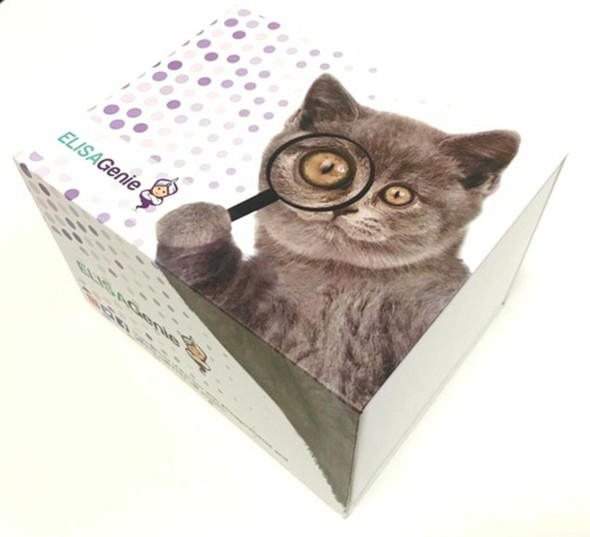Human MMP14 ELISA Kit (HUFI00303)
- SKU:
- HUFI00303
- Product Type:
- ELISA Kit
- Size:
- 96 Assays
- Uniprot:
- P50281
- Sensitivity:
- 18.75pg/ml
- Range:
- 31.25-2000pg/ml
- ELISA Type:
- Sandwich
- Synonyms:
- MMP14, MMP-14, MMP-X1, MT1-MMP, MT-MMP1, matrix metallopeptidase 14, membrane-inserted, membrane type 1 metalloprotease, Membrane-type matrix metalloproteinase 1, Membrane-type-1 matrix metalloproteinase, MT1MMP, MTMMP1
- Reactivity:
- Human
Description
Human MMP14 ELISA Kit
The Human MMP14 ELISA Kit is a powerful tool for researchers looking to accurately measure levels of MMP14 in human samples such as serum, plasma, and cell culture supernatants. This kit offers high sensitivity and specificity, providing dependable and consistent results for a variety of research applications.Matrix metalloproteinase 14 (MMP14) is a key enzyme involved in extracellular matrix remodeling and plays a crucial role in processes such as cell migration, tissue repair, and tumor invasion.
Abnormal MMP14 expression has been linked to conditions like cancer, arthritis, and cardiovascular diseases, making it a valuable biomarker for understanding disease mechanisms and exploring potential therapeutic targets.With the Human MMP14 ELISA Kit, researchers can confidently quantify MMP14 levels in human samples, paving the way for groundbreaking discoveries and advancements in the field of biomedical research.
| Product Name: | Human MMP14 ELISA Kit |
| Product Code: | HUFI00303 |
| Size: | 96 Assays |
| Alias: | MMP14, MMP-14, MMP-X1, MT1-MMP, MT-MMP1, matrix metallopeptidase 14, membrane-inserted, membrane type 1 metalloprotease, Membrane-type matrix metalloproteinase 1, Membrane-type-1 matrix metalloproteinase, MT1MMP, MTMMP1 |
| Detection method: | Sandwich ELISA, Double Antibody |
| Application: | This immunoassay kit allows for the in vitro quantitative determination of Human MMP14 concentrations in serum plasma and other biological fluids. |
| Sensitivity: | 18.75pg/ml |
| Range: | 31.25-2000pg/ml |
| Storage: | 4°C for 6 months |
| Note: | For Research Use Only |
| Recovery: | Matrices listed below were spiked with certain level of Human MMP14 and the recovery rates were calculated by comparing the measured value to the expected amount of Human MMP14 in samples. | ||||||||||||||||
| |||||||||||||||||
| Linearity: | The linearity of the kit was assayed by testing samples spiked with appropriate concentration of Human MMP14 and their serial dilutions. The results were demonstrated by the percentage of calculated concentration to the expected. | ||||||||||||||||
| |||||||||||||||||
| CV(%): | Intra-Assay: CV<8% Inter-Assay: CV<10% |
| Component | Quantity | Storage |
| ELISA Microplate (Dismountable) | 8×12 strips | 4°C for 6 months |
| Lyophilized Standard | 2 | 4°C/-20°C |
| Sample/Standard Dilution Buffer | 20ml | 4°C |
| Biotin-labeled Antibody(Concentrated) | 120ul | 4°C (Protect from light) |
| Antibody Dilution Buffer | 10ml | 4°C |
| HRP-Streptavidin Conjugate(SABC) | 120ul | 4°C (Protect from light) |
| SABC Dilution Buffer | 10ml | 4°C |
| TMB Substrate | 10ml | 4°C (Protect from light) |
| Stop Solution | 10ml | 4°C |
| Wash Buffer(25X) | 30ml | 4°C |
| Plate Sealer | 5 | - |
Other materials and equipment required:
- Microplate reader with 450 nm wavelength filter
- Multichannel Pipette, Pipette, microcentrifuge tubes and disposable pipette tips
- Incubator
- Deionized or distilled water
- Absorbent paper
- Buffer resevoir
| Uniprot | P50281 |
| UniProt Protein Function: | MMP14: Seems to specifically activate progelatinase A. May thus trigger invasion by tumor cells by activating progelatinase A on the tumor cell surface. May be involved in actin cytoskeleton reorganization by cleaving PTK7. Up-regulated by NANOS1. Expressed in stromal cells of colon, breast, and head and neck. Expressed in lung tumors. Belongs to the peptidase M10A family. |
| UniProt Protein Details: | Protein type:EC 3.4.24.80; Protease; Motility/polarity/chemotaxis; Membrane protein, integral Chromosomal Location of Human Ortholog: 14q11.2 Cellular Component: extracellular matrix; focal adhesion; Golgi lumen; integral to plasma membrane; cytoplasm; melanosome; plasma membrane Molecular Function:integrin binding; protein binding; protease activator activity; zinc ion binding; metalloendopeptidase activity; calcium ion binding; transcription factor activity Biological Process: extracellular matrix organization and biogenesis; tissue remodeling; negative regulation of focal adhesion formation; male gonad development; embryonic cranial skeleton morphogenesis; proteolysis; positive regulation of cell growth; collagen catabolic process; extracellular matrix disassembly; regulation of transcription, DNA-dependent; branching morphogenesis of a tube; ovarian follicle development; response to estrogen stimulus; response to mechanical stimulus; endothelial cell proliferation; response to hypoxia; zymogen activation; response to oxidative stress; angiogenesis; astrocyte cell migration; lung development; positive regulation of cell migration; endochondral ossification Disease: Winchester Syndrome |
| NCBI Summary: | Proteins of the matrix metalloproteinase (MMP) family are involved in the breakdown of extracellular matrix in normal physiological processes, such as embryonic development, reproduction, and tissue remodeling, as well as in disease processes, such as arthritis and metastasis. Most MMP's are secreted as inactive proproteins which are activated when cleaved by extracellular proteinases. However, the protein encoded by this gene is a member of the membrane-type MMP (MT-MMP) subfamily; each member of this subfamily contains a potential transmembrane domain suggesting that these proteins are expressed at the cell surface rather than secreted. This protein activates MMP2 protein, and this activity may be involved in tumor invasion. [provided by RefSeq, Jul 2008] |
| UniProt Code: | P50281 |
| NCBI GenInfo Identifier: | 317373419 |
| NCBI Gene ID: | 4323 |
| NCBI Accession: | P50281.3 |
| UniProt Secondary Accession: | P50281,Q6GSF3, Q92678, A8K5L0, |
| UniProt Related Accession: | P50281 |
| Molecular Weight: | 65,894 Da |
| NCBI Full Name: | Matrix metalloproteinase-14 |
| NCBI Synonym Full Names: | matrix metallopeptidase 14 (membrane-inserted) |
| NCBI Official Symbol: | MMP14 |
| NCBI Official Synonym Symbols: | MMP-14; MMP-X1; MT-MMP; MT1MMP; MTMMP1; WNCHRS; MT1-MMP; MT-MMP 1 |
| NCBI Protein Information: | matrix metalloproteinase-14; membrane type 1 metalloprotease; membrane-type-1 matrix metalloproteinase |
| UniProt Protein Name: | Matrix metalloproteinase-14 |
| UniProt Synonym Protein Names: | MMP-X1; Membrane-type matrix metalloproteinase 1; MT-MMP 1; MTMMP1; Membrane-type-1 matrix metalloproteinase; MT1-MMP; MT1MMP |
| Protein Family: | Matrix metalloproteinase |
| UniProt Gene Name: | MMP14 |
| UniProt Entry Name: | MMP14_HUMAN |
*Note: Protocols are specific to each batch/lot. For the correct instructions please follow the protocol included in your kit.
Before adding to wells, equilibrate the SABC working solution and TMB substrate for at least 30 min at 37°C. When diluting samples and reagents, they must be mixed completely and evenly. It is recommended to plot a standard curve for each test.
| Step | Protocol |
| 1. | Set standard, test sample and control (zero) wells on the pre-coated plate respectively, and then, record their positions. It is recommended to measure each standard and sample in duplicate. Wash plate 2 times before adding standard, sample and control (zero) wells! |
| 2. | Aliquot 0.1ml standard solutions into the standard wells. |
| 3. | Add 0.1 ml of Sample / Standard dilution buffer into the control (zero) well. |
| 4. | Add 0.1 ml of properly diluted sample ( Human serum, plasma, tissue homogenates and other biological fluids.) into test sample wells. |
| 5. | Seal the plate with a cover and incubate at 37 °C for 90 min. |
| 6. | Remove the cover and discard the plate content, clap the plate on the absorbent filter papers or other absorbent material. Do NOT let the wells completely dry at any time. Wash plate X2. |
| 7. | Add 0.1 ml of Biotin- detection antibody working solution into the above wells (standard, test sample & zero wells). Add the solution at the bottom of each well without touching the side wall. |
| 8. | Seal the plate with a cover and incubate at 37°C for 60 min. |
| 9. | Remove the cover, and wash plate 3 times with Wash buffer. Let wash buffer rest in wells for 1 min between each wash. |
| 10. | Add 0.1 ml of SABC working solution into each well, cover the plate and incubate at 37°C for 30 min. |
| 11. | Remove the cover and wash plate 5 times with Wash buffer, and each time let the wash buffer stay in the wells for 1-2 min. |
| 12. | Add 90 µl of TMB substrate into each well, cover the plate and incubate at 37°C in dark within 10-20 min. (Note: This incubation time is for reference use only, the optimal time should be determined by end user.) And the shades of blue can be seen in the first 3-4 wells (with most concentrated standard solutions), the other wells show no obvious color. |
| 13. | Add 50 µl of Stop solution into each well and mix thoroughly. The color changes into yellow immediately. |
| 14. | Read the O.D. absorbance at 450 nm in a microplate reader immediately after adding the stop solution. |
When carrying out an ELISA assay it is important to prepare your samples in order to achieve the best possible results. Below we have a list of procedures for the preparation of samples for different sample types.
| Sample Type | Protocol |
| Serum | If using serum separator tubes, allow samples to clot for 30 minutes at room temperature. Centrifuge for 10 minutes at 1,000x g. Collect the serum fraction and assay promptly or aliquot and store the samples at -80°C. Avoid multiple freeze-thaw cycles. If serum separator tubes are not being used, allow samples to clot overnight at 2-8°C. Centrifuge for 10 minutes at 1,000x g. Remove serum and assay promptly or aliquot and store the samples at -80°C. Avoid multiple freeze-thaw cycles. |
| Plasma | Collect plasma using EDTA or heparin as an anticoagulant. Centrifuge samples at 4°C for 15 mins at 1000 × g within 30 mins of collection. Collect the plasma fraction and assay promptly or aliquot and store the samples at -80°C. Avoid multiple freeze-thaw cycles. Note: Over haemolysed samples are not suitable for use with this kit. |
| Urine & Cerebrospinal Fluid | Collect the urine (mid-stream) in a sterile container, centrifuge for 20 mins at 2000-3000 rpm. Remove supernatant and assay immediately. If any precipitation is detected, repeat the centrifugation step. A similar protocol can be used for cerebrospinal fluid. |
| Cell culture supernatant | Collect the cell culture media by pipette, followed by centrifugation at 4°C for 20 mins at 1500 rpm. Collect the clear supernatant and assay immediately. |
| Cell lysates | Solubilize cells in lysis buffer and allow to sit on ice for 30 minutes. Centrifuge tubes at 14,000 x g for 5 minutes to remove insoluble material. Aliquot the supernatant into a new tube and discard the remaining whole cell extract. Quantify total protein concentration using a total protein assay. Assay immediately or aliquot and store at ≤ -20 °C. |
| Tissue homogenates | The preparation of tissue homogenates will vary depending upon tissue type. Rinse tissue with 1X PBS to remove excess blood & homogenize in 20ml of 1X PBS (including protease inhibitors) and store overnight at ≤ -20°C. Two freeze-thaw cycles are required to break the cell membranes. To further disrupt the cell membranes you can sonicate the samples. Centrifuge homogenates for 5 mins at 5000xg. Remove the supernatant and assay immediately or aliquot and store at -20°C or -80°C. |
| Tissue lysates | Rinse tissue with PBS, cut into 1-2 mm pieces, and homogenize with a tissue homogenizer in PBS. Add an equal volume of RIPA buffer containing protease inhibitors and lyse tissues at room temperature for 30 minutes with gentle agitation. Centrifuge to remove debris. Quantify total protein concentration using a total protein assay. Assay immediately or aliquot and store at ≤ -20 °C. |
| Breast Milk | Collect milk samples and centrifuge at 10,000 x g for 60 min at 4°C. Aliquot the supernatant and assay. For long term use, store samples at -80°C. Minimize freeze/thaw cycles. |






